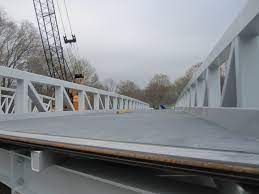Executive Summary
Steel-reinforced concrete bridges in coastal North Carolina are exposed to aggressive environments conducive of corrosion. The extent of deterioration is such that two typical cored-slab bridges (Bridge No.: 150035 and 150039, investigated as part of RP2014-35 at NC State University) on US70 in Carteret County (near Harkers Island) were replaced after just 37 years of service. This situation is not unique to these bridges and represents a considerable financial burden to the NCDOT. Similarly, the new Harkers Island Bridge will replace Bridge No.'s 96 and 73 on Harkers Island Road, the only vehicular link to the island from the mainland. Bridge No. 96 was built in 1970 with a cored-slab superstructure (of the type investigated by the research team previously) that was replaced in 2013 after 43 years of service due to significant deterioration. Bridge No. 73 was built in 1969 and is currently classified as structurally deficient and is load posted at SV 24, TTST 37.
An effective way to address this common durability problem is to eliminate one of the sources resulting in corrosion, which in this case is the internal steel reinforcing. To this end, the use of non-corroding fiber-reinforced polymer (FRP) internal reinforcement in concrete bridge construction is a demonstrated viable alternative to steel reinforcement. Typical maintenance and repair associated with corrosion in steel reinforced concrete is eliminated, increasing the useful service life before the need for superstructure replacement. The first prestressed concrete bridge to use the same system proposed for the Harkers Island Bridge replacement is the Sinmiya Bridge in Japan that was built in 1988 and has been service for 32 years with no signs of deterioration. The Harker's Island Bridge replacement will be the first fully FRP-reinforced concrete bridge in North Carolina. Hence, this provides a unique opportunity to quantify the mechanical characteristics of the materials used, and test and monitor the performance of the bridge system starting from the manufacture of the precast elements through to the operation of the bridge. The observations and data collected will serve as a benchmark and validate material specifications and design decisions made so that future FRP-reinforced bridge design and construction may be optimized and made more efficient. It will also provide the data needed to enable direct comparison of the durability of future bridge replacements using stainless steel reinforcing.

The proposed 3-year research program aligns with the construction schedule of the bridge and consists of 7 complex and multi-disciplinary tasks related to a common theme that may be broadly categorized in 3 interrelated parts, namely, (1) material characterization, (2) monitoring, and (3) structural performance.
The research team is ideally suited to address the objectives of this research program and contains the complementary technical experience necessary to ensure the successful achievement of the expected outcomes, which include: (i) A record of the physical and mechanical property test results as required by the Special Provisions of the NCDOT Standard Specifications. (ii) A record of the manufacture of the precast elements and the in-situ construction for comparison with NCDOT material, construction, and design specifications, which also serves as a historical record for future reference of long-term performance. (iii) A long-term inspection and monitoring plan, including data on the initial performance of the bridge for comparison with design predictions. (iv) Means by which actual field data may be obtained in the long-term to enable more accurate load rating assessment including, for example, prestress losses. And (v) recommendations and best-practices based on observations and data collected from the project to improve future design, construction, and assessment of FRP reinforced and prestressed concrete bridges by, for example, revising Special Provisions or NCDOT Standard Specifications, revising design procedures to more accurately predict performance, and revising biennial inspection requirements to ore relevant information.
